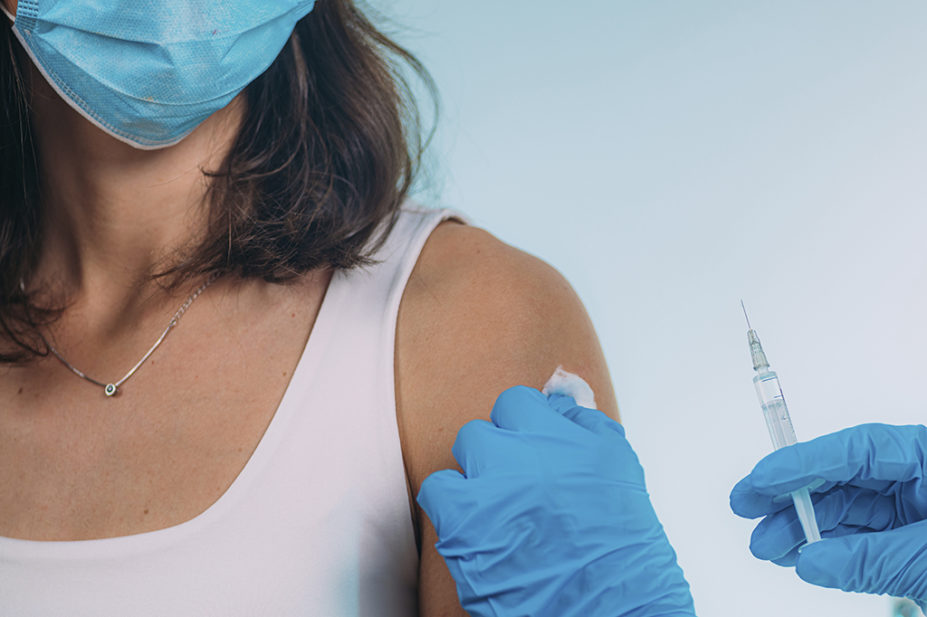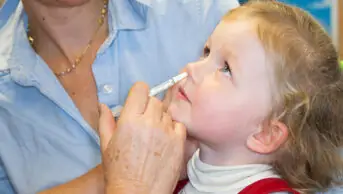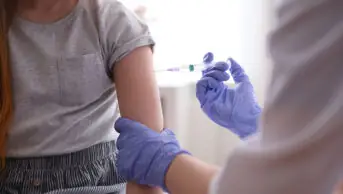
Science Photo Library
Open access article
The Royal Pharmaceutical Society has made this article free to access in order to help healthcare professionals stay informed about an issue of national importance. To learn more about coronavirus, please visit: https://www.rpharms.com/resources/pharmacy-guides/wuhan-novel-coronavirus
Since the first vaccine was approved in late 2020, more than half (61.4%) of the UK adult population has received their first dose of a COVID-19 vaccine, while 15.5% are fully vaccinated, having received their second dose. A tremendous effort, but we cannot rest on our laurels — there is still much work to be done. We must not forget the reasoning behind the UK’s COVID-19 vaccination strategy, which will help us address some of the issues that may affect a successful vaccine programme.
The endgame has been to reduce hospital admissions
The aim of the first phase of the COVID-19 vaccination programme was to divorce high infection rates in the community from, inevitably, leading to huge peaks in hospital admissions and deaths caused by COVID-19-related pneumonia.
The Joint Committee on Vaccination and Immunisation (JCVI) used the excellent data from large UK electronic dataset studies (such as QCOVID[1] with 6 million subjects, and OpenSAFELY[2] with 17 million subjects) on the factors related to dying from COVID-19 to decide on the prioritisation categories. The data revealed the risk of severe disease is dominated by the effects of ageing, to a much larger extent than other diseases. Mortality after catching COVID-19 stands at around 10% for those aged over 80 years; 2.5% for people in their 70s; and 1% for people in their 60s. Nursing home residents are particularly susceptible to COVID-19, with a 20−30% mortality risk. However, for those aged under 30 years, the chance of dying is very low: about 1 in 50,000[1,2].
These data led to the age-based priority groups for the first phase of the vaccination programme, starting with nursing home residents, then the over 80s, over 75s and so on down to age 50 years. There were three additional groups:
- Healthcare workers in direct contact with patients, owing to their higher risk of infection and the chance of them infecting their patients; and to minimise sickness in a workforce under enormous strain;
- An extremely vulnerable group with high-risk comorbidities, such as haematological cancer or Down’s syndrome;
- A group with less severe comorbidities, such as diabetes and chronic lung, heart, renal and liver diseases.
Decision to delay the second-dose of the vaccine
At the end 2020, the JCVI also decided to delay the second dose of both the Oxford/AstraZeneca and Pfizer vaccines to up to 12 weeks after the first, rather than 4 weeks after. This decision divided opinion. However, data from the trials of both vaccines showed quite clearly that one dose of the vaccine provided most of the protective efficacy and, by delaying the second dose, a higher proportion of the at-risk population could be protected in a shorter period than if the second dose was given after 4 weeks[3,4]. Furthermore, the data for the Oxford/AstraZeneca vaccine (and likely to be true for the Pfizer vaccine as well) showed giving the second dose after 10–12 weeks markedly improved antibody responses, which is likely to sustain stronger protection against the virus over the long term[4].
Real-life results are in and they’re very promising
Real-life data on vaccine effectiveness are now available from both the UK and Israel, and is very encouraging. The data show that one dose of either the Pfizer or Oxford/AstraZeneca vaccine reduces hospitalisation and mortality with COVID-19 by around 80% or greater[5,6]. In addition, several studies show that one dose of the vaccine reduces the chance of getting mild or symptomatic COVID-19 by around 50%, and perhaps by 85% after two doses. These data suggest vaccination could also protect the high-risk population indirectly by preventing the spread of COVID-19 in the general population. This strategy was not considered for the first phase of the vaccination programme, partly because of the overriding need to prevent deaths directly, which, at the time, were very high, but also because the clinical trial data were not able to assess whether the vaccines controlled the spread of COVID-19. More recent data further support a role for vaccination in preventing disease transmission. This will be important for phase two of the vaccination programme, as it suggests vaccines will reduce the need for social distancing measures to suppress circulating infection.
How we can ensure the programme’s success
What are the main issues with the future of the vaccination programme now that we have finished phase one? There are three main (and inter-related) ones to consider: maximising vaccine uptake by high-risk groups; safety concerns; and variant strains of SARS-CoV-2.
1. Increasing vaccine uptake
Firstly, we can understand why we need a high uptake of the vaccine by using a simplified assessment of the effects of the pandemic in the UK before the vaccine became available. Each of the two COVID-19 waves infected roughly 10–12% of the population and resulted in 50,000–60,000 deaths. Unfortunately, future waves of infection are very likely to occur unless social distancing is maintained or reinstated when infection rates start to rise, but for political and socioeconomic reasons, this is unlikely to be sustainable. During these waves of community transmission, the 5% of vulnerable people who have not been vaccinated and those in whom the vaccine has not worked (perhaps 5%, but hopefully closer to 1%) will be susceptible to infection. This represents a large number of people and could lead to a further 25,000 deaths. This is why we need to ensure a very high vaccine uptake (95–99%) in high-risk groups. These groups also need to receive their second dose of the vaccine as this will maximise their protection against severe COVID-19 infection, hopefully reducing mortality by as much as 99%.
Despite the increased risk of severe disease among ethnic minorities, vaccine uptake is 20–25% lower in some of these groups, as well as in certain geographic regions (for example, London) and in people from lower socioeconomic backgrounds. This is a serious concern: there is a risk that while high rates of vaccination for most of the population will markedly reduce the overall incidence of severe COVID-19 infection in the UK, this risk may not fall for particular communities with much lower rates of vaccination.
Specifically, without lockdown to reduce infection rates during further waves of COVID-19 infection, inner city areas with a high proportion of ethnic minorities could have rates of severe disease and death not dissimilar to the first and second waves. This must not be repeated.
2. Addressing safety worries
The reduced rates of vaccination in some groups is related both to poorer access to vaccination, and to hesitancy largely driven by safety concerns, rather than antagonism towards vaccines in general. Pharmacists, as trusted healthcare providers, can make a major contribution towards addressing safety concerns and providing easy access to vaccines. They can inform their worried customers about the benefits of the vaccine, allay safety concerns and directly deliver the vaccine in communities that may have poorer provision of other vaccine services, such as mass vaccination centres and GP surgeries.
The concerns with vaccine safety are essentially three-fold: side effects; anaphylaxis; and blood clots.
Many people have a flu-like reaction immediately after the vaccination, which can include fatigue, malaise, fever and a headache. These are expected side effects and almost always resolve within a couple of days; if necessary, they can be relieved using paracetamol.
Anaphylaxis is very rare and is more likely with the Pfizer vaccine owing to a chemical (polyethylene glycol [PEG]) in the vaccine preparation. Only people who have a history of anaphylaxis to multiple agents or to PEG should not receive the vaccine.
There have been concerns raised as to whether COVID-19 vaccines cause blood clots. Fortunately, the UK and European regulatory bodies, and the World Health Organization, clearly state the vaccine is safe and there is no overall increased risk of blood clots after receiving either the Pfizer or the Oxford/AstraZeneca vaccine. There is, however, an unusual combination of low platelet counts and aggressive clots affecting different parts of the body, often the large veins in the brain (cerebral sinuses), that seems to be associated with the Oxford/AstraZeneca and perhaps other adenoviral vector vaccines. This has been described in around 10 people per 1 million vaccine doses, which is roughly the chance of dying in a road traffic accident in the next 3 or 4 months, and too low a risk for any individual person to be concerned about.
Importantly, groups targeted by the first phase of the UK COVID-19 vaccine programme have around a 1% chance of dying if they catch COVID-19; that is 10,000 deaths per 1 million, which far outweighs any risk associated with vaccination. It is only in younger adults who have a very low risk of severe COVID-19 infection that the advice is to receive a different vaccine to the Oxford/AstraZeneca vaccine.
Any concerns around effects on fertility, not being able to breastfeed or having long-term side effects are all unfounded.
3. Some protection against variants is better than none
The last issue is whether the vaccine will protect against the multiple SARS-CoV-2 variants that have been identified. The available data are incomplete but do suggest the vaccine still prevents severe infections and deaths caused by the new SARS-CoV-2 variants. However, it is likely that for some variants (for example, the South African variant, B1.351) vaccine-induced protection against mild or asymptomatic infection will be weaker. In that case, there is a risk that these variants — if they become prevalent in the UK — will make phase two of the vaccination programme (vaccinating healthy under 50s) less effective at suppressing overall infection rates. This risk further emphasises the need to vaccinate a very high proportion of high-risk people to minimise future severe COVID-19 infections. Future vaccines are also likely to target new viral variants to help overcome this issue.
The COVID-19 vaccine programme in the UK has, so far, been very successful, but we cannot afford to become complacent. A high uptake in high-risk groups is essential. Without protection in these groups, there are likely to be ongoing severe infections that could still devastate specific communities, especially those with lower vaccine uptake. Through their direct interactions with the local community, pharmacists will have a vital role in ensuring a high uptake of COVID-19 vaccines in the populations that really need it, and helping the country to recover from the pandemic.
Jeremy S Brown, practising specialist in respiratory medicine; professor of respiratory infection, UCL Respiratory, University College London; subcommittee member, Joint Committee on Vaccination and Immunisation
- 1Clift AK, Coupland CAC, Keogh RH, et al. Living risk prediction algorithm (QCOVID) for risk of hospital admission and mortality from coronavirus 19 in adults: national derivation and validation cohort study. BMJ 2020;:m3731. doi:10.1136/bmj.m3731
- 2Williamson EJ, Walker AJ, Bhaskaran K, et al. Factors associated with COVID-19-related death using OpenSAFELY. Nature 2020;584:430–6. doi:10.1038/s41586-020-2521-4
- 3Polack FP, Thomas SJ, Kitchin N, et al. Safety and Efficacy of the BNT162b2 mRNA Covid-19 Vaccine. N Engl J Med 2020;383:2603–15. doi:10.1056/nejmoa2034577
- 4Voysey M, Clemens SAC, Madhi SA, et al. Safety and efficacy of the ChAdOx1 nCoV-19 vaccine (AZD1222) against SARS-CoV-2: an interim analysis of four randomised controlled trials in Brazil, South Africa, and the UK. The Lancet 2021;397:99–111. doi:10.1016/s0140-6736(20)32661-1
- 5Dagan N, Barda N, Kepten E, et al. BNT162b2 mRNA Covid-19 Vaccine in a Nationwide Mass Vaccination Setting. N Engl J Med 2021;384:1412–23. doi:10.1056/nejmoa2101765
- 6Torjesen I. Covid-19: First doses of vaccines in Scotland led to a substantial fall in hospital admissions. BMJ 2021;:n523. doi:10.1136/bmj.n523


